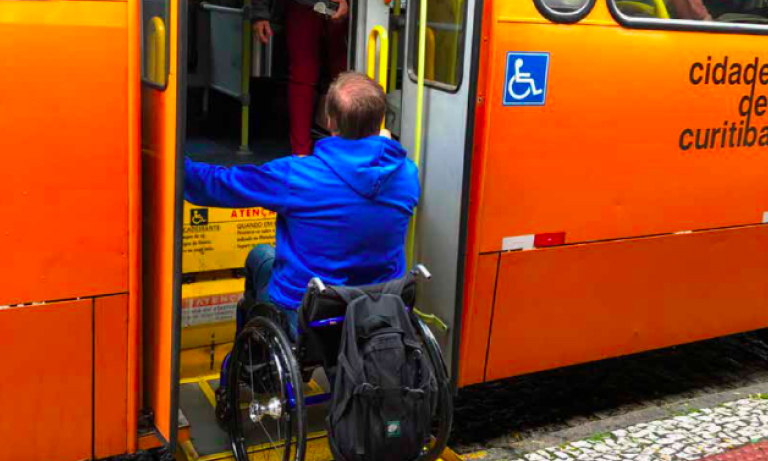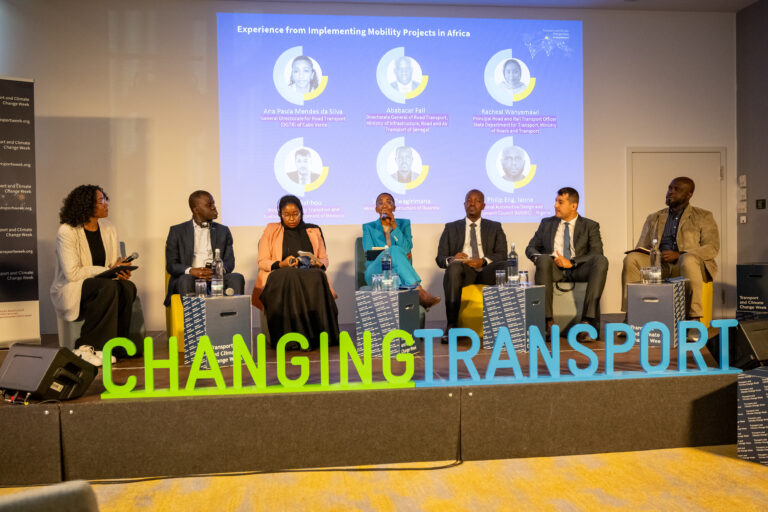Crafting Safer and More Inclusive Routes in Curitiba – Inter-American Development Bank

Report on Urban Mobility and Sustainable Development in Curitiba, Brazil
1.0 Introduction: Aligning Urban Transport with Sustainable Development Goals
The city of Curitiba, Brazil, a historical leader in sustainable urban mobility, is currently undertaking a comprehensive program to modernize its public transport system. This initiative, supported by the Inter-American Development Bank (IDB), directly addresses critical challenges in accessibility and safety, aligning the city’s development with key United Nations Sustainable Development Goals (SDGs). The project focuses on creating an inclusive transport network that serves all residents, particularly those in vulnerable situations, thereby advancing SDG 11 (Sustainable Cities and Communities), SDG 10 (Reduced Inequalities), and SDG 5 (Gender Equality). The daily experiences of residents—such as a visually impaired man navigating inaccessible crossings, a wheelchair user forced into traffic due to a lack of sidewalks, and a female student altering her route to avoid unlit, unsafe areas—underscore the urgent need for infrastructure that is equitable and safe for all.
2.0 Identified Barriers to Sustainable and Inclusive Mobility
An assessment of Curitiba’s public transport system revealed significant barriers preventing the city from fully achieving its sustainable development targets. These challenges disproportionately affect vulnerable populations and hinder progress on multiple SDGs.
- Lack of Accessibility for Persons with Disabilities: In a city with 300,000 residents with a disability, the transport system presents numerous physical and operational obstacles. This systemic failure directly contravenes the objectives of SDG 10 (Reduced Inequalities) and SDG 11.2, which calls for accessible transport systems for persons with disabilities. Key issues include:
- Absence of audible signals at traffic lights for the visually impaired.
- Inconsistent announcements for bus stops.
- Malfunctioning accessibility equipment, such as wheelchair lifts.
- Lack of continuous and safe sidewalks, forcing individuals with mobility impairments into dangerous road conditions.
- Gender-Based Safety Concerns: Women, who constitute 61% of public transport users, face significant harassment and safety risks. This environment limits their freedom of movement and access to opportunities, undermining SDG 5 (Gender Equality) and the goal of safe public spaces under SDG 11. A 2017 study indicated that 37.1% of Brazilian women had experienced harassment in the previous year. Many women in Curitiba report avoiding travel at night or rejecting work and educational opportunities due to unsafe commutes.
3.0 Project Framework: The Inter 2 Direct Line Modernization
To address these deficiencies, the city is implementing a program focused on the Inter 2 Direct Line, a critical corridor connecting 28 neighborhoods and serving 580,000 people. The project’s design is rooted in a user-centric approach to ensure that infrastructure improvements directly contribute to the SDGs.
3.1 Methodologies for Data-Driven, Inclusive Planning
To ensure the project effectively targets the needs of all users, two primary diagnostic tools were employed to gather qualitative and quantitative data.
- Customer Journey Maps: This methodology traced the travel experiences of diverse user profiles to identify specific barriers. By accompanying users and documenting their perspectives, the project team gained insights crucial for achieving SDG 10. The profiles included:
- A man with a physical disability
- An elderly woman
- A pregnant woman
- A young woman with a cognitive disability
- A young woman with a hearing disability
- A woman caring for a child
This process identified physical, operational, communication, and attitudinal barriers at twelve distinct stages of a journey, ensuring that solutions are based on lived experiences.
- Gendered Walkability Index: To specifically address SDG 5, this tool was used to assess the quality and safety of public spaces for women and girls. Technical personnel conducted surveys along four routes during both day and night to evaluate factors like public lighting, pedestrian infrastructure, and perceived safety. The findings directly inform interventions aimed at mitigating gender-based violence and harassment.
4.0 Expected Outcomes and Contribution to the 2030 Agenda
The insights gathered are being integrated into the planning and implementation of infrastructure upgrades along the Inter 2 Direct Line. The project is expected to deliver measurable progress toward several Sustainable Development Goals.
- Advancement of SDG 11 (Sustainable Cities and Communities): The program will create a safer, more accessible, and sustainable public transport system for a significant portion of the city’s population, directly fulfilling the mandate of Target 11.2.
- Promotion of SDG 5 (Gender Equality): By incorporating design elements that enhance safety, such as improved lighting and route options, the project aims to reduce harassment and empower women to move freely, thereby increasing their access to social and economic opportunities.
- Commitment to SDG 10 (Reduced Inequalities): Upgrades focused on universal accessibility will dismantle barriers for persons with disabilities and the elderly, ensuring they have equitable access to the city’s transport network.
- Support for SDG 8 (Decent Work and Economic Growth): By providing a reliable, safe, and accessible transport system, the project will enable more residents, particularly women and persons with disabilities, to access employment and educational opportunities, fostering inclusive economic growth.
Analysis of Sustainable Development Goals in the Article
1. Which SDGs are addressed or connected to the issues highlighted in the article?
-
SDG 5: Gender Equality
- The article highlights the issue of harassment and gender-based violence against women in public transport. It describes the experience of Luciana, who alters her travel routes to avoid poorly lit areas out of fear. It also cites a statistic that “37.1% of Brazilian women stated that they had been victims of harassment in the last 12 months,” directly connecting the urban mobility problem to gender inequality and safety.
-
SDG 10: Reduced Inequalities
- The article focuses heavily on the exclusion of persons with disabilities from full participation in urban life due to inaccessible infrastructure. The stories of João, who is visually impaired and struggles with traffic lights without audible signals, and Júnior, who uses a wheelchair and is forced onto dangerous roads due to a lack of sidewalks, exemplify the inequalities faced by the 300,000 residents with disabilities in Curitiba. The project’s goal is to reduce these barriers and promote inclusion.
-
SDG 11: Sustainable Cities and Communities
- The core theme of the article is improving urban mobility in Curitiba, a key component of a sustainable city. It discusses the city’s Bus Rapid Transit system and the need to make it and its surrounding infrastructure (sidewalks, lighting, bus stops) safe, inclusive, and accessible for all residents, particularly vulnerable groups like women and people with disabilities. The project on the “Inter 2 Direct Line” is a direct effort to create a more sustainable and inclusive urban transport system.
2. What specific targets under those SDGs can be identified based on the article’s content?
-
SDG 5: Gender Equality
- Target 5.2: “Eliminate all forms of violence against all women and girls in the public and private spheres…” The article directly addresses this target by focusing on harassment and gender-based violence in public transport, a public sphere. The use of the “Gendered Walkability Index” and efforts to improve public lighting are concrete actions aimed at making public spaces safer for women, thus contributing to the elimination of violence and harassment.
-
SDG 10: Reduced Inequalities
- Target 10.2: “By 2030, empower and promote the social, economic and political inclusion of all, irrespective of age, sex, disability…” The project’s focus on understanding and removing the “physical, operational, communications, and attitudinal barriers” for people with disabilities, as detailed through the experiences of João and Júnior, is a direct effort to promote their social and economic inclusion. By making transport accessible, the project enables them to get to work, physiotherapy, and participate more fully in society.
-
SDG 11: Sustainable Cities and Communities
- Target 11.2: “By 2030, provide access to safe, affordable, accessible and sustainable transport systems for all, improving road safety, notably by expanding public transport, with special attention to the needs of those in vulnerable situations, women, children, persons with disabilities and older persons.” This target is the central focus of the article. The entire Curitiba project described is about improving the public transport system to be more accessible for people with disabilities (Júnior’s elevator access) and safer for women (Luciana’s concerns about lighting).
- Target 11.7: “By 2030, provide universal access to safe, inclusive and accessible, green and public spaces…” The article discusses the quality of public spaces beyond the bus itself, such as “cracked sidewalks,” “dangerous intersections,” and areas “without public lighting.” The use of the “Gendered Walkability Index” to assess the quality of public spaces for pedestrians directly aligns with this target of ensuring universal access to safe and inclusive public spaces.
3. Are there any indicators mentioned or implied in the article that can be used to measure progress towards the identified targets?
-
For SDG 5 (Target 5.2)
- Implied Indicator: The article mentions that “37.1% of Brazilian women stated that they had been victims of harassment in the last 12 months.” A reduction in this percentage among public transport users in Curitiba would be a direct indicator of progress. The “Gendered Walkability Index” itself serves as a composite indicator, measuring the quality and safety of public spaces for women.
-
For SDG 10 (Target 10.2)
- Implied Indicator: The article describes the use of “Customer Journey Maps” to meticulously identify “physical, operational, communications, and attitudinal barriers.” The number and severity of these identified barriers can serve as a baseline indicator. Progress can be measured by the reduction or elimination of these specific barriers (e.g., number of traffic lights with audible signals installed, percentage of bus elevators that are functional).
-
For SDG 11 (Targets 11.2 and 11.7)
- Implied Indicator for Target 11.2: The article mentions that women have “rejected work or study opportunities due to commute lengths or because they want to avoid traveling at night.” An indicator of progress would be a decrease in the number of people, particularly women, who turn down opportunities due to unsafe or inaccessible transport. Another indicator is the accessibility of the system, measured by the successful implementation of features like audible signals and functioning elevators for wheelchairs.
- Implied Indicator for Target 11.7: The lack of “public lighting” is cited as a major safety concern. Therefore, an indicator of progress would be the percentage of the “Inter 2 Direct Line” route and its surrounding pedestrian areas that are equipped with adequate public lighting. The scores from the “Gendered Walkability Index” can also be used as a quantitative measure of the quality of these public spaces.
4. Table of SDGs, Targets, and Indicators
| SDGs | Targets | Indicators (Mentioned or Implied in the Article) |
|---|---|---|
| SDG 5: Gender Equality | 5.2: Eliminate all forms of violence against all women and girls in the public and private spheres. |
|
| SDG 10: Reduced Inequalities | 10.2: Empower and promote the social, economic and political inclusion of all, irrespective of… disability. |
|
| SDG 11: Sustainable Cities and Communities | 11.2: Provide access to safe, affordable, accessible and sustainable transport systems for all… with special attention to the needs of… women… [and] persons with disabilities. |
|
| SDG 11: Sustainable Cities and Communities | 11.7: Provide universal access to safe, inclusive and accessible… public spaces. |
|
Source: iadb.org
What is Your Reaction?
 Like
0
Like
0
 Dislike
0
Dislike
0
 Love
0
Love
0
 Funny
0
Funny
0
 Angry
0
Angry
0
 Sad
0
Sad
0
 Wow
0
Wow
0
















































/environment-climate-change-and-health-(ech)/water-sanitation-hygiene-and-health-(wsh)/landfill-tuvalu-36092.tmb-1200v.jpg?sfvrsn=5c21fe40_1#)

.jpg.webp?itok=0ZsAnae9#)























